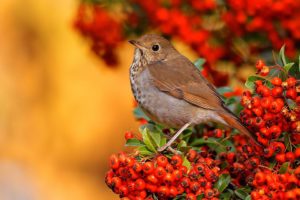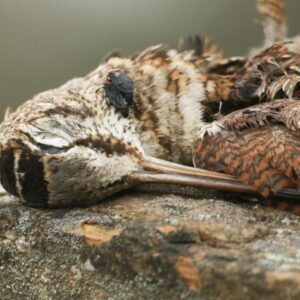The Melancholic Hermit Thrush
The November 2018 Calendar image is taken by Hui Sim and truly captures the Hermit Thrush in its natural environment – feeding on berries, its food of choice, before a late fall migration.
an unassuming artist
The Hermit Thrush is an unassuming bird whose melancholy song can be recognized in forest openings or along trails. During the summertime months the Hermit Thrush lurks in the understories of far northern forests, often in clearings or near the edges of trails. They migrate north earlier in the spring and linger later in fall than the other brown-back thrushes. As such, the Hermit Thrush the only one likely to be seen in winter in North America, most often,near berry-bearing plants, as it is in our cover image!

A Hermit Thrush’s chunky shape is similar to that of an American Robin, differing in size, as it is only slightly smaller. It has a rich brown upper body and smudged spots on the breast, with a reddish tail. This a characteristic is what sets it apart from similar species in its genus, such as the Wood Thrush or Swainson’s Thrush!
As a forager, the Hermit Thrush spends much of its time on the ground, picking up insects from leaf-litter or soil. On occasion it can be seen picking up patches of grass and shaking them, to release any insects that may have been hiding in it! Its diet is made up of mostly berries and a variety of insects, including beetles, ants, caterpillars, true bugs, grasshoppers, crickets, and many others!
where can we spot a hermit thrush?
Hermit Thrushes usually make their nests in and around trees and shrubs, but they can also get more creative! Nests have been found in mine shafts, golf courses and even in cemeteries! It is the males that usually gather food for the nest, while the females feed the nestlings. The nestlings are typically ready to fly at about 12 days.
Unfortunately for bird lovers, Hermit Thrushes rarely visit backyards, and are not generally interested in bird feeders. Our only opportunity to see a Hermit Thrush nearby is, as was Hui’s, before their late fall migration when they forage on the ground or eat berries in yards with trees or shrubs.
They might be hard to spot – but if you take a listen to this video, you’ll know how to identify it by its song!



